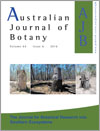Australian Journal of Botany
Volume 64
Number 6 2016
Water and soil pollution promotes environmental degradation and interferes with the fauna and flora, and pollutants such as arsenic (As) are toxic to most organisms. Plant populations that grow on polluted and unpolluted sites have differences in As-tolerance, and more efficient strategies to combat the toxic effects of the metalloid have been identified in plants from the contaminated site. The identification of As-tolerant plant species/populations allows for their use in the revegetation of areas contaminated with this element.
Little information is available regarding the influence of snowfall on BSCs in desert ecosystems. In this present study, we assessed the effects of snowfall on photosynthesis, moisture contents, and concentrations of soluble protein and malondialdehyde (MDA). On the basis of these analyses, we discussed the necessity and importance of snowfall for cyanobacterial crusts in desert regions.
In Tasmania, snow does not usually persist over the winter outside 86 ha in 119 snow patches. There are five floristic communities in these patches, all being distinct from those in mainland Australian snow patches. The Tasmanian snow patches merit listing as a threatened ecosystem on the basis of their distinctiveness and restricted extent.
Sporobolus phleoides is a potential resource for saline environments. Its seeds showed non-deep physiological dormancy, which was removed with puncturing treatments. Six different evaluated populations showed similar germination responses, especially when they were subjected to cold stratification. This factor appears to be determinant on seedling establishment in natural environments.
Anatomical characteristics are important for taxonomic studies on different plant families. The present study focussed on four Brazilian Aldama species (Asteraceae family) that were chosen because they are difficult to identify and have biological and pharmacological potential. All four species analysed could be differentiated on the basis of the set of anatomical features described for each species. So, we concluded that anatomy is able to provide data to assist with the taxonomic problems within the four species analysed herein.
Following cessation of Aboriginal land management, the temperate wilderness of south-western Tasmania has been burnt by infrequent, extensive wildfires, including in 2013. We surveyed the effects of this wildfire and found that it killed most woody vegetation in sedge-heathland. Fire severity was affected by time since previous fire, with the wildfire self-extinguishing near the boundary of a milder management fire set 2 years earlier. Our study demonstrated how prescribed burning can create landscape heterogeneity and limit megafires.
Resource allocation within montane wetlands was tested against nutrient, fire and disturbance frequency gradients. High nutrients and low disturbance favoured polycarpic species, large leaves and fruit. Low nutrients and moderate disturbance favoured woody polycarpy and larger seeds. Frequently inundation favoured soil stored diaspores and monocarpy with rapid vegetative growth.
Woody plant density has increased in many ecosystems, but whether this is principally driven by post-disturbance recovery or a cessation of disturbance events is contested. We examined which these best explain changes in river red gum forests along the Murray River, using stumps to infer historic forest structure.
Extrafloral nectaries (EFNs) attract ants that can provide defence against herbivorous insects, although the outcomes of this mutualism can vary greatly. For the dioecious shrub, Adriana quadripartita, the presence of ants tending EFNs reduced herbivore numbers; however, herbivore numbers were overall greater on male plants and ants reduced leaf damage on male but not female plants. In the context of this and previous studies on Adriana, plant sex is another factor that is likely to influence the outcomes of this ant–plant–herbivore interaction.
Approved and proposed mineral sands mines in the Murray–Darling Basin have the potential to adversely affect large tracts of land with spinifex–mallee vegetation. Broad-scale revegetation of this vegetation type has not been attempted in south-eastern Australia, but a small-scale revegetation trial at Wemen in Victoria’s semiarid north-west indicated much promise with hand-planting of tubestock of spinifex (Triodia scariosa) and mallee eucalypts. Although spatially limited, the results of this trial suggest that spinifex tubestock planted at high densities can achieve restoration objectives for this component of spinifex–mallee vegetation.




